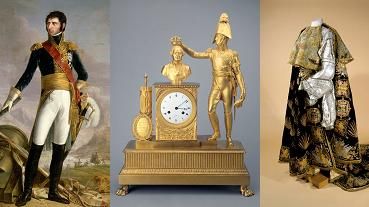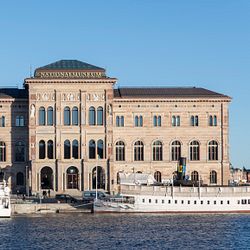
Press release -
Staging Power – the art of governing through art
This autumn, Nationalmuseum presents the magnificent exhibition Staging Power – Napoleon, Karl Johan, Alexander.
On show will be some 420 items - a collection of portraits, costumes,
jewellery and other art wares – all telling a story of honour and power.
The exhibition is about the art of governing through art.
Nationalmuseum is joining forces with the State Hermitage, St. Petersburg, to present this autumn’s magnificent exhibition Staging Power – Napoleon, Karl Johan, Alexander.
On show will be a wealth of historical artefacts and fine artisan
wares, all of which have some connection with the three protagonists. It
is a collection of some 420 items - portraits, costumes, jewellery and
other art wares – all telling a story of honour and power. The
exhibition is about the art of governing through art.
The lives of Napoleon, Karl Johan and Alexander were interwoven in the early 19th century. Napoleon Bonaparte was the soldier who seized power in a bloodless coup and crowned himself emperor of the French people. Jean-Baptiste Bernadotte was the field marshal in Napoleon’s army who was chosen as heir to the Swedish throne and assumed the name of Karl Johan. Alexander was born to be tsar of Russia but ascended the throne under coup-like circumstances following his father’s assassination. Relations between Karl Johan and Napoleon had long been frosty and soon deteriorated. In need of allies, Karl Johan approached Alexander, and Sweden and Russia formed an alliance against Napoleonic France. Eventually it was Alexander who succeeded to break Napoleon’s dominance in Europe, which was the beginning of the end for Napoleon and his empire.
War and insecurity dominated daily life in the early 19th century. The French Revolution had overturned traditional social structures, opening up new career opportunities. Soldiers were seen as models, in art as well as life. Art was used to demonstrate legitimacy but also as a means of governing, reflecting the self-image and claims of those in power. Napoleon, Karl Johan and Alexander were all skilled at using art to strengthen their position. Nothing was left to chance, so even a simple object like a teacup or a toothpick case might carry a political message. Symbols of war abounded in the architecture, art and crafts of this period, even finding their way into interior design. The exhibition will cover topics such as Visual manifestations of power, International politics and dynastic family ties, and Art collecting.
The exhibition runs from 30 September 2010 to 23 January 2011.
Further information
Hanna Tottmar, press officer: htr@nationalmuseum.se, +46 8 5195 4390
Captions
Joseph Nicolas Jouy after François JosephKinson, Jean Baptiste Bernadotte, Marshal of France, King of Sweden and Norway, 1818 © RMN (Château de Versailles)/Gérard Blot
Pierre-Philippe Thomire, attributed, Table clock with Alexander I crowning a bust of Louis XVIII© The State Hermitage Museum
Unknown French manufacturer, Alexander I’s costume for the Order of the Knights of the Holy Spirit© The State Hermitage Museum
Jacob Frères, attributed, after a sketch by Charles Percier, Gondola chair (or demi-fauteuil) from the Empress Joséphine’s boudoir at Saint-Cloud © Musée national des Châteaux de Malmaison et Bois Préau
Categories

